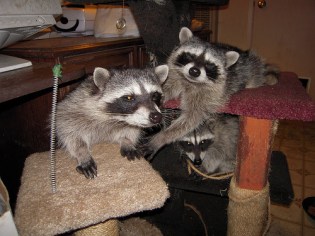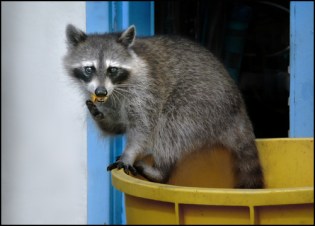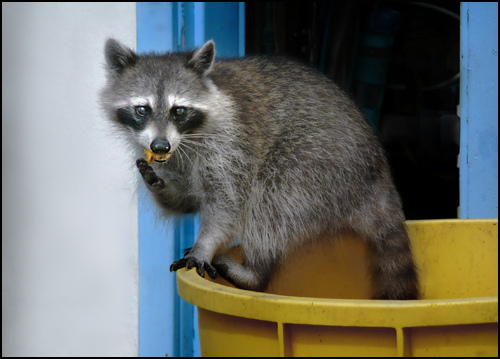
Meet your new neighbor. He's got lots of friends. (Photo by Pip R. Lagenta.)
Raccoons are going to take over the earth. Or at least move into your apartment.
OK, they probably aren’t, but that was the impression I got while watching the Nature documentary Raccoon Nation, which I caught one recent night on PBS. (You can watch it here.)
The premise of the show is that urban habitats could actually be making raccoons smarter. Omnivorous, curious, intelligent, and super-adaptable, raccoons are turning out to be really good at overcoming every challenge that people throw at them. Cities are like giant playgrounds for them, filled with puzzles that they can solve with surprising ease — and learn from in the process.
In Brooklyn, N.Y., where I live, one family came downstairs in the morning to find a dead raccoon wedged in their silverware drawer. The resulting picture (yikes) got passed around local blogs for days. It’s a horrible image, but it got a very different reaction than a similar picture of a rat or a snake would have elicited: People felt bad for the raccoon as much as they did for the person who stumbled down for breakfast and encountered its furry corpse.
Because here’s the thing about raccoons: Unlike other animals that people encounter rummaging through their garbage, they’re freaking adorable.

Just borrowing the fax. (Photo by Pip R. Lagenta.)
Their masked mugs are just so wildly cute, as is the way they use their front paws (which are incredibly sensitive, allowing the animal to take in enormous amounts of information about its environment). In the same building where the dead-raccoon-in-a-drawer incident took place, residents couldn’t keep from videotaping and cooing about the antics of other raccoons that were doing their best to bust into the house.
“People have a different kind of relationship with raccoons,” says Stanley Gehrt, associate professor at Ohio State University, one of the raccoon researchers featured in the Nature show. “People kind of identify with them. There’s an increased comfort level. People are actually feeding them and adopting them.”
Which is not such a great idea. In Toronto, which according to Nature is “the raccoon capital of the world,” the animals are causing lots of problems. There are concerns not just about property damage, but also about the spread of diseases such as rabies and raccoon roundworm. One homeowner got so fed up with the raccoon family that was destroying his garden that he attacked them with a shovel — and got arrested for animal cruelty. The episode provoked a small rally, complete with pro- and anti-raccoon camps.
The Nature show included segments on how the furry critters are destroying centuries-old Buddhist temples in Japan, where they were introduced after a ’70s TV show called “Rascal the Raccoon” convinced people that they would make cute pets. Owners dumped them once they grew up and got vicious, and as a result Japan is filled with raccoons that are basically turning some of the country’s most historic buildings into toothpicks by nesting in them.

Look who came to dinner. (Photo by ImageMD.)
People try all sorts of things to get rid of raccoons: rags soaked in ammonia, mothballs, cayenne pepper, coyote piss, strobe lights, ultrasonic noise machines, you name it. And guess what? To quote the honey badger, raccoon don’t care.
Removing food sources, trapping and relocating the raccoons, and sealing up any available hole where they can enter are the best strategies, but they don’t always work. In Japan, they’re just killing them: A biologist interviewed on the Nature program estimates she’s done away with 10,000 of the beasts. She looks like it has made her pretty sad. But still they come.
In Germany, raccoons were imported for hunting and fur, and there’s a thriving population in German cities like Kassel, where there are today about 100 raccoons per square kilometer (0.39 square mile). Characteristically, the Germans have tried to solve the problem through engineering, creating ingenious shields to keep raccoons from climbing up drainpipes and into houses. Except the raccoons seem to figure them out as soon as they’re created.
Gehrt is not totally sold on the idea that cities make raccoons smarter, saying that much more research needs to be done. What’s clear, he told me, is that people and wild animals are coming into contact more and more frequently. Cities are getting greener, providing habitat. People are more tolerant of wildlife than they used to be, seeing the presence of wild animals as a life-enhancing glimpse of nature rather than as a menace. And for hyper-adaptable animals like the raccoon, the city is a safe haven, with no hunting or trapping and no predators. Figure out which streets are too busy to cross safely (which they seem to be able to do pretty quickly), locate your local garbage can, and you’re living the raccoon high life.
The crux of the issue is that raccoons are a lot like people: clever, opportunistic, adaptable, and fiendishly persistent. Also, street smart as all hell. They like cities almost as much as we do.
For better or worse, we have unwittingly hooked up with raccoons for the long run.


